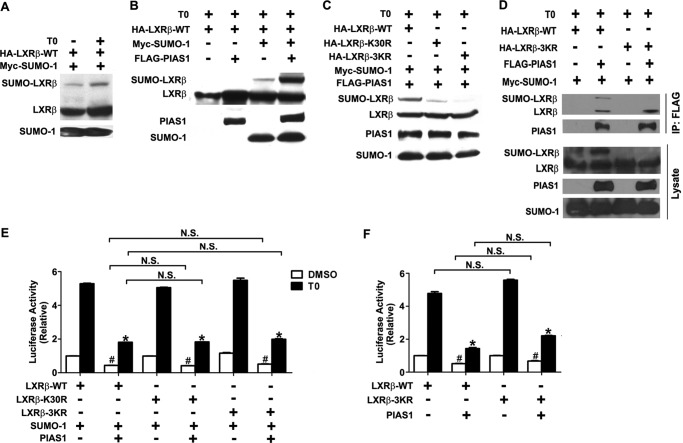FIGURE 5.
PIAS1 affects the transcriptional activity of LXRβ in a SUMO modification-independent fashion. A, LXR agonist promoted SUMO1 conjugation to LXRβ. 293T cells were transiently co-transfected for 30 h with Myc-SUMO-1 along with HA-LXRβ-WT as indicated. Cells were then treated with DMSO or 5 μm T0901317 for 12 h. Cell lysates were prepared in the presence of 20 mm N-ethylmaleimide, and Western immunoblotting was performed using anti-HA or anti-Myc antibody. SUMO1-conjugated HA-LXRβ is indicated. B, PIAS1 enhanced SUMO1 modification of LXRβ. 293T cells were co-transfected for 30 h with HA-LXRβ-WT with or without Myc-SUMO-1 or FLAG-PIAS1 as indicated. Cells were then treated with 5 μm T0901317 for 12 h, and cell lysates were analyzed by immunoblotting using the tag antibodies. C, lysine residue 30 of LXRβ was the major site for PIAS1-promoted SUMO1 modification. 293T cells were co-transfected with the indicated plasmids, including those encoding HA-tagged WT or K30R and 3KR mutant forms of LXRβ. Cells were likewise treated and analyzed by immunoblotting. D, 293T cells were co-transfected for 48 h with the indicated plasmids and then treated with 5 μm T0901317 for 12 h. Immunoprecipitation (IP) was performed with anti-FLAG, and immunoblotting was conducted using the tag antibodies. Results in A–D are representative of at least two independent experiments. E and F, PIAS1-mediated SUMO1 modification was not required to suppress the transcriptional activity of LXRβ. 293T cells were co-transfected with the TK-LXRE3-Luc construct and the indicated plasmids, with (E) or without (F) Myc-SUMO1. Cells were subsequently treated with either DMSO or 5 μm T0901317 for 12 h before luciferase assays. Data are presented as means ± S.E., with the value for each LXRβ construct normalized to DMSO-treated control without FLAG-PIAS1 (set as 1). *, p < 0.05; #, p < 0.05 versus T0901317 (T0)- or DMSO-treated cells without FLAG-PIAS1 by two-way ANOVA. N.S., no significance.

